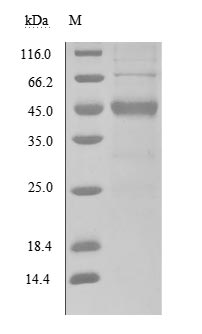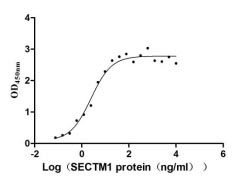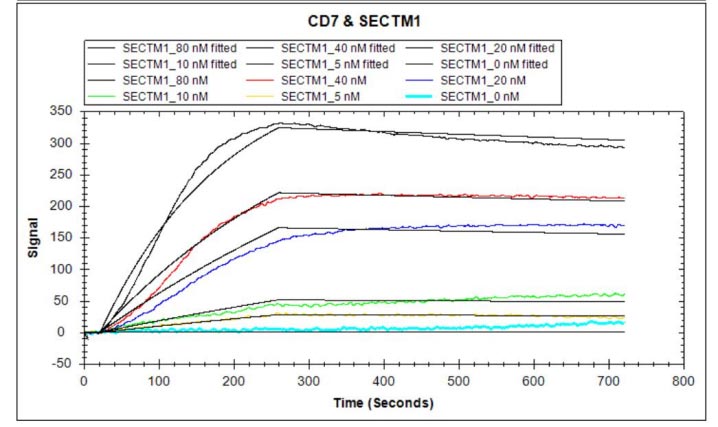The recombinant human SECTM1 protein is created in mammalian cells using a plasmid containing the target gene that corresponds to the 29-145aa of the human SECTM1. The target gene is co-expressed with the C-terminal hFc-tag gene. SDS-PAGE demonstrates a purity of this SECTM1 protein exceeding 85%, and the endotoxin levels of this SECTM1 protein are below 1.0 EU/μg, as measured by the LAL method. ELISA testing confirms the SECTM1 protein's functional activity, showing its binding to the CD7 (CSB-MP004953HU) with an EC50 between 1.811 and 3.372 ng/mL. In an LSPR assay, the human CD7 protein (CSB-MP004953HU) captured on the COOH chip can bind to this human SECTM1 protein with an affinity constant of 1.84 nM.
Human SECTM1 (K12) is a transmembrane and secreted protein that plays a significant role in immune modulation and cellular signaling. It is primarily expressed in various immune cells, including T cells and NK cells, and is induced by IFN-γ [1][2][3]. SECTM1 functions as a co-stimulatory ligand for CD7, a glycoprotein found on T and NK cells, enhancing their activation and proliferation [2][4][5]. This interaction is crucial for the immune response, particularly in the context of infections and tumors, where SECTM1 can facilitate the recruitment and activation of immune cells [6][7].
In the context of cancer, SECTM1 is expressed in various malignancies, including breast and prostate cancers, where it may contribute to tumor progression by attracting monocytes through CD7-mediated signaling pathways [6][7]. Furthermore, studies have indicated that SECTM1 can enhance the expression of activation markers in NK cells, suggesting its potential utility in immunotherapy [2][5].
In addition to its role in T cell activation, SECTM1 has been implicated in various inflammatory processes. SECTM1 has been shown to promote neutrophil recruitment during lung infections, thereby contributing to the inflammatory response [8]. The protein's involvement in inflammation is further supported by its expression in conditions such as systemic sclerosis and its association with other inflammatory markers [1][3]. SECTM is also involved in the regulation of signaling pathways critical for cell survival and proliferation, such as the TGFβ/Smad pathway in glioblastoma [7].
References:
[1] T. Papadimitriou. Cd7 activation regulates cytotoxicity-driven pathology in systemic sclerosis, yielding a target for selective cell depletion, Annals of the Rheumatic Diseases, vol. 83, no. 4, p. 488-498, 2023. https://doi.org/10.1136/ard-2023-224827
[2] T. Wang, C. Huang, A. López-Coral, K. Slentz-Kesler, M. Xiao, E. Wherry, et al. K12/sectm1, an interferon-γ regulated molecule, synergizes with cd28 to costimulate human t cell proliferation, Journal of Leukocyte Biology, vol. 91, no. 3, p. 449-459, 2011. https://doi.org/10.1189/jlb.1011498
[3] Y. Li, S. Deng, X. Wang, W. Huang, J. Chen, N. Robbins, et al. Sectm1a deficiency aggravates inflammation-triggered cardiac dysfunction through disruption of lxrα signalling in macrophages, Cardiovascular Research, vol. 117, no. 3, p. 890-902, 2020. https://doi.org/10.1093/cvr/cvaa067
[4] R. Ehmann, K. Brandes, M. Antwerpen, M. Walter, K. Schlippenbach, E. Stegmaier, et al. Molecular and genomic characterization of a novel equine molluscum contagiosum-like virus, Journal of General Virology, vol. 102, no. 3, 2021. https://doi.org/10.1099/jgv.0.001357
[5] C. Georgiadis, J. Rasaiyaah, S. Gkazi, R. Preece, A. Etuk, A. Christi, et al. Base-edited car t cells for combinational therapy against t cell malignancies, Leukemia, vol. 35, no. 12, p. 3466-3481, 2021. https://doi.org/10.1038/s41375-021-01282-6
[6] T. Wang, Y. Ge, M. Xiao, A. López-Coral, L. Li, A. Roesch, et al. Sectm1 produced by tumor cells attracts human monocytes via cd7-mediated activation of the pi3k pathway, Journal of Investigative Dermatology, vol. 134, no. 4, p. 1108-1118, 2014. https://doi.org/10.1038/jid.2013.437
[7] Z. Yao. Sectm1 promotes the development of glioblastoma and mesenchymal transition by regulating the tgfβ1/smad signaling pathway, International Journal of Biological Sciences, vol. 20, no. 1, p. 78-93, 2024. https://doi.org/10.7150/ijbs.84591
[8] E. Pereira. Transcriptional profiling of sars-cov-2-infected calu-3 cells reveals immune-related signaling pathways, Pathogens, vol. 12, no. 11, p. 1373, 2023. https://doi.org/10.3390/pathogens12111373









